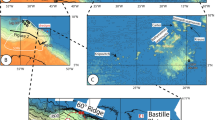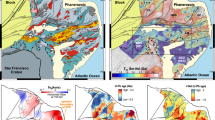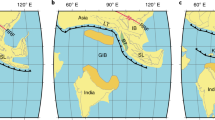Abstract
Now that the nature of the Morarian orogenesis (about 730 Myr BP) is becoming more apparent1,2 it seems appropriate to assess its significance in terms of late Proterozoic history of the northern Atlantic region. It has been argued3 that the event is related to subduction, with a suture partly coinciding with the Great Glen Fault. The event has also been associated with the closing of a Precambrian ocean during the time represented by the unconformity between the Stoer and Torridon groups4. The Proto-Atlantic opened after the deposition of the Torridon Group. In establishing the orogenic character of the Morarian Event several features are important. First, the event is known to have affected Moine rocks in a zone some 20 km wide. If, as seems likely, the Morarian fabric can be traced as far south as the Great Glen Fault then the belt is some 50 km wide after the Caledonian shortening. Until more is known about the geology of Sutherland, however, it is uncertain whether the entire length of the Moine outcrop (about 250 km) is involved. There is no reason to believe that the Morarian fabric is present to the south of the Great Glen Fault: the likelihood is that the Central Highland Granulites (often named the Moines nowadays) represent post-Moine sediments, but the possibility that they are Moines that were not influenced by the Morarian Orogeny cannot be excluded. Until this problem is resolved it would be prudent to revive the name Central Highlands Granulite for the sub-Dalradian rocks occurring to the south of the Great Glen Fault.
This is a preview of subscription content, access via your institution
Access options
Subscribe to this journal
Receive 51 print issues and online access
$199.00 per year
only $3.90 per issue
Buy this article
- Purchase on Springer Link
- Instant access to full article PDF
Prices may be subject to local taxes which are calculated during checkout
Similar content being viewed by others
References
Van Breeman, O., Pidgeon, R. T., and Johnson, M. R. W., J. geol. Soc. Lond., 130, 493–507 (1974).
Powell, D., J. geol. Soc. Lond., 130, 575–590 (1974).
Garson, M., and Plant, J., Nature phys. Sci., 242, 34–37 (1973).
Dewey, J. F., and Kidd, W. S. F., Geology, 2, 543–546 (1974).
Tanner, P. W. G., Johnstone, G. S., Smith, D. I., and Harris, A. L., Bull. geol. Soc. Am., 81, 299–306 (1970).
Read, H. H., Mem. geol. Surv. U.K. (1931).
Soper, N. J., Scott. J. Geol., 7, 241–247 (1971).
Dewey, J. F., and Bird, J. M., J. geophys. Res., 75, 2625–2647 (1970).
Gayer, R. A., et al., Skr. norsk Polarinst., 137 (1966).
Phillips, W. E. A., and Taylor, W. E. G., Sci. Proc. R. Dublin Soc., A311–329 (1975).
Hadley, J. B., in Tectonics of the Southern Appalachians (edit. by Lowry, W. D.), 33–44 (VPI Department of Geological Sciences Mem. 1, 1964).
Wynne-Edwards, H. R., and Hassan, Z. U., Am. J. Sci., 268, 289–308 (1970).
Donaldson, J. A., Irvine, E., McGlynn, G. C., and Pack, J. K., in Implications of Continental Drift to the Earth Sciences (edit. by Tarling, D. H., and Runcorn, S. K.), (Academic, London, 1973).
Author information
Authors and Affiliations
Rights and permissions
About this article
Cite this article
JOHNSON, M. Morarian Orogeny and Grenville Belt in Britain. Nature 257, 301–302 (1975). https://doi.org/10.1038/257301a0
Received:
Accepted:
Published:
Issue Date:
DOI: https://doi.org/10.1038/257301a0
This article is cited by
Comments
By submitting a comment you agree to abide by our Terms and Community Guidelines. If you find something abusive or that does not comply with our terms or guidelines please flag it as inappropriate.



